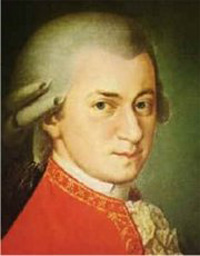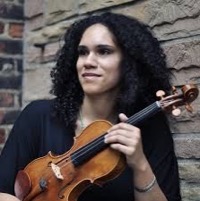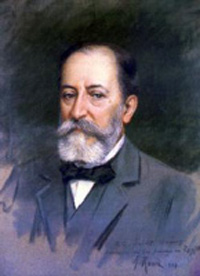| Mozart & Saint-SaŽns and Montgomery's Starburst | ||||||||||
Symphony No. 39 in E-flat major, K. 543 Mozart composed the three symphonies Nos. 39 through 41 in 1788 for a series of autumn concerts to be performed in Vienna. With the exception of the Clarinet Concerto and the Piano Concerto in B-flat, K 595, these symphonies represent the culmination of Mozart's orchestral music. Given their position in Mozart’s biography, a good deal of mythology has accrued concerning these symphonies among which are: Mozart never heard these works performed in concert; the G minor Symphony (No. 40) represents the outpouring of the composer’s tragic despair and even premonition of his early death. In fact, it is likely that the 1788 Vienna concerts actually did come off. The revisions of the G minor and “Jupiter “ symphonies suggest that Mozart carried all three in his portfolio for tours through Germany in 1789 and 1790. At least one of them was also performed in 1791, the year of Mozart’s death; the conductor was Antonio Salieri (Mozart’s fictionalized mediocre nemesis in the play and film Amadeus). What is true about the period of the composition of these symphonies is that Mozart was suffering from severe financial problems. Many of these difficulties were clearly of his own making – he borrowed from one creditor to pay off another while still trying desperately to live high off the hog. But circumstances beyond Mozart's control were also affecting his finances; Emperor Joseph II's war with Turkey drained funds that might otherwise have been spent on the arts; as a result, concerts and opera sharply declined after 1788. Symphony No. 39 is unusual in its scoring for winds. Taking advantage of the middle European love affair with the recently developed clarinet, Mozart substitutes the newest member of the winds for the usual oboes. The work opens with a majestic – even menacing – slow introduction  leading rather unexpectedly into a sprightly 6/8 Allegro. Mozart connects the introduction and Allegro through the transformation of a series of descending scales in the violins in both sections. The Allegro, in sonata allegro form, consists of two composite themes or theme groups: The principal motives in the first group are leading rather unexpectedly into a sprightly 6/8 Allegro. Mozart connects the introduction and Allegro through the transformation of a series of descending scales in the violins in both sections. The Allegro, in sonata allegro form, consists of two composite themes or theme groups: The principal motives in the first group are  & &  . The second theme group also includes several different motives; it begins . The second theme group also includes several different motives; it begins  , but it is this middle figure that forms the basis of the development section , but it is this middle figure that forms the basis of the development section  . .While the first movement calls Haydn's "Drumroll" Symphony, No. 103, to mind, the second, andante con moto, might possibly have influenced Schubert. In this movement and in Schubert's "Unfinished" Symphony, a lilting, optimistic theme is sharply contrasted with a dark minor middle section. The movement repeats a little melody, fragments of which will recur throughout as a kind of refrain.  In contrast to this quiet theme, another bursts in almost angrily as a response to it. In contrast to this quiet theme, another bursts in almost angrily as a response to it.  The Minuet is a rather heavy-handed stomp, more like Haydn than the usual Mozartean elegance  . The Trio, however, lightens things up with a more delicate clarinet solo. . The Trio, however, lightens things up with a more delicate clarinet solo.  The Finale is all about seven little notes, an upbeat motive that pervades the entire movement.  In the first theme it appears as follows: In the first theme it appears as follows:  The second theme in this sonata form is virtually the same as the first, but continues on a somewhat different tack. The second theme in this sonata form is virtually the same as the first, but continues on a somewhat different tack.  And the movement ends exactly as it began. And the movement ends exactly as it began.  | ||||||||||
Starburst Jessie Montgomery composed Starburst in 2012 for the Sphinx Virtuosi, a chamber orchestra of 18 of the nation’s top Black and Latinx classical soloists, primarily alumni of the internationally renowned Sphinx Competition. (Sphinx crisscrosses the country inspiring aspiring young musicians of color.) She writes about Starburst: This brief one-movement work for string orchestra is a play on imagery of rapidly changing musical colors. Exploding gestures are juxtaposed with gentle fleeting melodies in an attempt to create a multidimensional soundscape. A common definition of a starburst: “the rapid formation of large numbers of new stars in a galaxy at a rate high enough to alter the structure of the galaxy significantly” lends itself almost literally to the nature of the performing ensemble who premieres the work, The Sphinx Virtuosi, and I wrote the pecs with their dynamic in mind.Montgomery is a violinist, composer and educator with a graduate degree in Composition and Multimedia from New York University. She is a member of the Catalyst Quartet, and is a collaborator touring with cellist Yo-Yo Ma’s Silk Road Ensemble. Among her many contributions to musical organizations in the New York area, she performs and composes for the Sphinx Organization. A review of her debut album, Strum, Music for Strings, sums up her eclectic musical style: “The album combines classical chamber music with elements of folk music, spirituals, improvisation, poetry and politics, crafting a unique and insightful new-music perspective on the cross-cultural intersections of American history.” | ||||||||||
Cello Concerto in A minor, Op. 33 It is said that at his first public concert in May 1846 the ten-year-old Camille Saint-SaŽns, after playing Mozart and Beethoven piano concertos as well as some solo works by Bach and Handel, offered to play any one of Beethoven’s 32 piano sonatas as an encore – from memory. A child prodigy who grew to become a phenomenal polymath, Saint-SaŽns wrote articles and books on many scientific topics, including astronomy, biology and archaeology in addition to his composing and musicological studies. In his youth Saint-SaŽns was considered an innovator, but by the time he reached maturity he had become a pillar of the establishment, trying to maintain the classical musical tradition in France. As an accomplished organist and pianist – he premiered his five piano concertos – he sported an elegant, effortless technique. But neither his compositions nor his pianism were ever pinnacles of passion or emotion. Berlioz noted that Saint-SaŽns “...knows everything but lacks inexperience.” Saint-SaŽns was supportive of some younger composers, but his visceral dislike of Debussy actually engendered endless headlines in the tabloid press. The defeat of France at the hands of Prussia in 1871 shocked the country’s pride and spurred a revival of French arts and letters. One of the results was the founding by Saint-SaŽns and his colleagues of the Société Nationale de Musique, whose motto and purpose was “Ars gallica” (French art). One of its results was the establishment of three newly energized competing symphony orchestras in Paris by three great conductors - …douard Colonne, Jules-…tienne Pasdeloup and Charles Lamoureux - who urgently looked for new works by French composers. Saint-SaŽns composed the Cello Concerto in a minor in 1872 in response to this demand. It is in three continuous movements with no pauses, similar to the Cello Concerto by Robert Schumann. Unlike the standard classical concerto, Saint-SaŽns's Concerto opens with only a single orchestral chord, after which the soloist introducing the principal themes. The first one is an assertive and virtuosic melody that will be revisited throughout the Concerto as a unifying device.  The cello also introduces the standard contrasting second theme in the relative major mode. The cello also introduces the standard contrasting second theme in the relative major mode.  (Note how the flute sneaks in with the Concerto's motto.) The exposition concludes with an energetic closing motive. (Note how the flute sneaks in with the Concerto's motto.) The exposition concludes with an energetic closing motive.  There is virtually no development section in this movement, merely a varied restatement of the themes in order. The second theme gradually softens the mood and the music glides into the second movement, an understated minuet in the orchestra. There is virtually no development section in this movement, merely a varied restatement of the themes in order. The second theme gradually softens the mood and the music glides into the second movement, an understated minuet in the orchestra.  † When the cello enters, it plays a counter-melody over the minuet † When the cello enters, it plays a counter-melody over the minuet  and then a little waltz on its own. and then a little waltz on its own.  Again, the end of the Minuet blends without pause into the Finale. Again, the end of the Minuet blends without pause into the Finale.While many nineteenth century works bring back the opening theme at the very end as a way of providing closure and an arch-like structure, Saint-SaŽns expands greatly on this architectural concept. The Finale, the longest of the movements, continues the development of the opening theme of the concerto but also includes a new more expansive second theme,  as well as a burst of new thematic material, including a little orchestral refrain, and, of course, rapid scales, arpeggios and high harmonics that permit the soloist to indulge in virtuoso brilliance. as well as a burst of new thematic material, including a little orchestral refrain, and, of course, rapid scales, arpeggios and high harmonics that permit the soloist to indulge in virtuoso brilliance.  The Concerto concludes with a restatement of the opening theme and the closing motive from the first movement plus a coda that accelerates the tempo for a dramatic finish. The Concerto concludes with a restatement of the opening theme and the closing motive from the first movement plus a coda that accelerates the tempo for a dramatic finish. | ||||||||||
| Copyright © Elizabeth and Joseph Kahn 2019 | ||||||||||


